MARIANI’S
July
5, 2009
NEWSLETTER
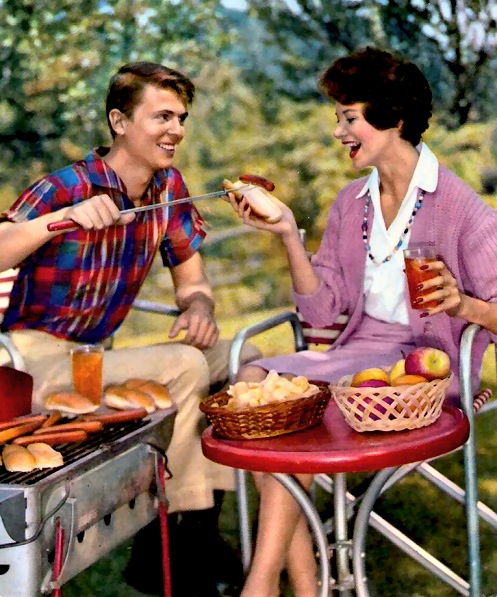
HAPPY FOURTH OF JULY WEEKEND!
QUESTIONS? TO REACH JOHN MARIANI WRITE
TO: newsletter@johnmariani.com.
ARCHIVE: Readers may now access
an
Archive of all past newsletters--each annotated--dating back to July,
2003, by simply clicking on www.johnmariani.com/archive
SUBSCRIBE AND
UN-SUBSCRIBE: You may subscribe anyone you wish
to this newsletter--free of charge--by
clicking here.
TO
READ MY STORY ON "SANDWICH CUISINE" IN DIVERSION MAGAZINE,
CLICK
HERE.
In
This Issue
The Espresso Wars Heat Up with New No-Fail Machines by John Mariani
NEW YORK CORNER: FINE ITALIAN DINING NORTH OF NYC
by John Mariani
NOTES FROM THE WINE CELLAR: The Douro Boys (and one Girl) by Mort Hochstein
QUICK BYTES
~~~~~~~~~~~~~
The Espresso Wars Heat Up
with New No-Fail Machines
by John Mariani
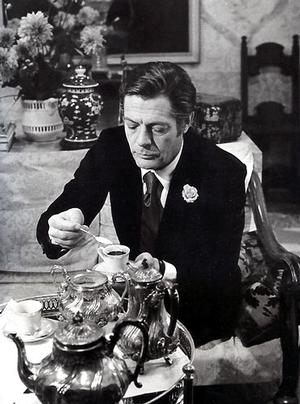 Despite
$30 billion U.S. coffee sales annually, most Americans don’t know
beans about coffee.
Despite
$30 billion U.S. coffee sales annually, most Americans don’t know
beans about coffee.
“Coffee is at least as complex as wine,”
insists Andrea Illy, the third-generation Chairman of
illycaffè S.p.A., whose grandfather Francesco invented the
espresso machine in the early 20th century. “In America people think of
coffee as just a drink with food. Even when people here buy our coffee
and
machines, even restaurants, they usually don’t make it properly and the
whole point of good espresso is lost.
“For years we have tried very hard to
educate our customers, but in the U.S. they don’t clean the machines
correctly, they don’t heat the cups, they serve it with lemon peel. But
now we are about to change that. We have made
espresso-making foolproof.”
I agree with every word of what Illy
says. It is so rare, even in an Italian restaurant in America, to
get even a drinkable cup of espresso that I have stopped asking for one.
At Dunkin’ Donuts,
which I think makes very good American-style coffee,
espresso now counts for 10% of their annual sales, but they serve the
stuff in paper cups, which is the first mistake in making a decent
espresso. (I will not even discuss de-caf decoctions as coffee at
all; it's like the difference between and bull and a steer.
Until the 1980s almost all
espresso in the U.S. was brewed in metal pots with two canisters (right), and it was usually awful,
made from cheap, bitter, burnt coffee grounds, which is why it was
usually served with a piece of lemon rind to improve the taste of
the sludge. Believe me, a ten-cent shot of Sambuca did nothing to
improve it either. You can make a perfectly nice cup of coffee with
such
a machine if you use good ground coffee beans, but it tastes nothing like espresso.
True espresso (which is not
spelled "expresso") is usually a mix of fine arabica beans with
darker, more robust robusto
beans, made with a machine intended for
two purposes only: espresso and cappuccino, techniques invented in
Milan at the turn of the last century. The first espresso machine
appeared in 1902. The story goes that it was a quick shot of
coffee before catching the Milan express trains.
Italy doesn’t grow any coffee
beans but it does import and roast them. The fellow who makes
your coffee in a café or bar is an expert called a barista, and he is
as fastidious about the humidity in the air and the correct grinding of
the roasted beans as he is about the temperature, size, and shape of
the cup. The machines are kept scrupulously clean and serviced. In
fact, a service contract is always a part of the purchase of an
espresso machine in Italy. An Italian would never be caught dead
drinking coffee
from a paper cup. Thus, it is difficult not to have a delicious,
well-made coffee in Italy. Believe me, prisoners in the worst jail in
Palermo get better coffee than most Americans get here, and that goes
for the diluted junk Italian-American restaurants generally serve, even
if they bought $10,000 espresso machines--of which there are dozens on
the
market--and expensive Italian beans. But who usually makes the coffee
in an American, even an Italian-American, restaurant? The busboy,
who wouldn’t know good coffee if it came up and bit him on the butt.
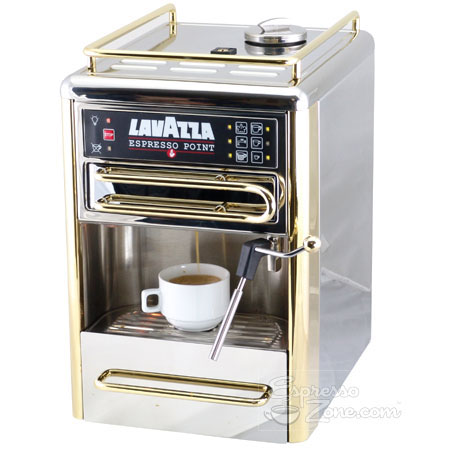 So
how do you get a good cup of
espresso in America? Stay home!
So
how do you get a good cup of
espresso in America? Stay home!
The reason is that coffeemakers have
indeed made the making of perfect espresso foolproof with their
machines, and the good news is that, owing to the world recession,
these machines are cheaper than ever.
In our house we have three espresso machines,
and all work beautifully. For more than ten years I have used a LavAzza Espresso Point, which
takes
little plastic cylinders perfectly packed with the right amount of
coffee, through which hot water is expressed into my short, impeccably
shaped ceramic espresso cup. If you leave the machne on during
the day,
as you should, the top of the unit warms your espresso cups. It is a
very handsome machine in gold and silver, and over the last decade,
I've
had very little trouble with it--a blown fuse I replaced myself and
another time a broken computer chip that ran about $150 in
repairs. Originally the machine cost me something in the range of
$800-$1000, but today it runs about $600-$700. The capsules cost
about 50 cents each, sent in boxes of packets. Compare this with the
absurd
price for a paper cup of Starbucks' and the machine will pay for
itself
within a year.
The literature on the made-in-Italy Point machine
claims that "Cleanup is
also simple, [as] used cartridges are
automatically ejected into a removable storage drawer each time a new
one is inserted, so your hands never get wet or dirty when
brewing." This is true, though a few coffee grounds still cause
an easy-to-clean residue into the exposed capsule holder. I
have been very happy
with the Point machine, but, now that Illy
and Nespresso make machines that work even better, and more cleanly, I
turn to them, too.
With an
array of beautifully designed machines with names like Le
Cube and the Essenza, Nespresso,
part 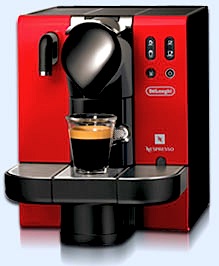 of Nestlé
Nespresso S.A., now has about a 23 percent market share of
espresso machines globally. Its products sell
in 50 countries, with more than 3,500 points of sale and more than 80
stylish
city
boutiques selling machines, cups, sugar, and coffee through a club
membership. Millions of Club
Members purchase monthly supplies of cartridges with names
like Lungo, Grands Crus from
various coffee regions, and many more, in jewel-bright
colors and handsome boxes. Last year Nespresso sold well over 2 billion
capsules.
of Nestlé
Nespresso S.A., now has about a 23 percent market share of
espresso machines globally. Its products sell
in 50 countries, with more than 3,500 points of sale and more than 80
stylish
city
boutiques selling machines, cups, sugar, and coffee through a club
membership. Millions of Club
Members purchase monthly supplies of cartridges with names
like Lungo, Grands Crus from
various coffee regions, and many more, in jewel-bright
colors and handsome boxes. Last year Nespresso sold well over 2 billion
capsules.
Nespresso’s newest machine is the Lattissima (right), made by De Longhi, which
amazingly makes a first-rate
cappuccino in just one step: You place a milk container in the machine,
pop in a coffee capsule (which runs about 55 cents each), push one
button; the frothy steamed milk fills
half the cup, followed by the espresso, which sinks beneath the cap of
foam. It’s an impressive process, with next to no cleaning
necessary, and the cappuccino is
excellent too. The home unit retails for $699-$799 online, but if you
order direct from Nespresso, the machine is currently only $499.
The site
also sells all the various accouterments for stylishness, from lovely
ceramic
and glass cups, trays, capsule drawers, teaspoons, and so on, so you
have a complete design center at your behest. And how does it all
taste? Wonderful, especially since you have so many options for
stypes and styles of beans, roasts, and grinds.
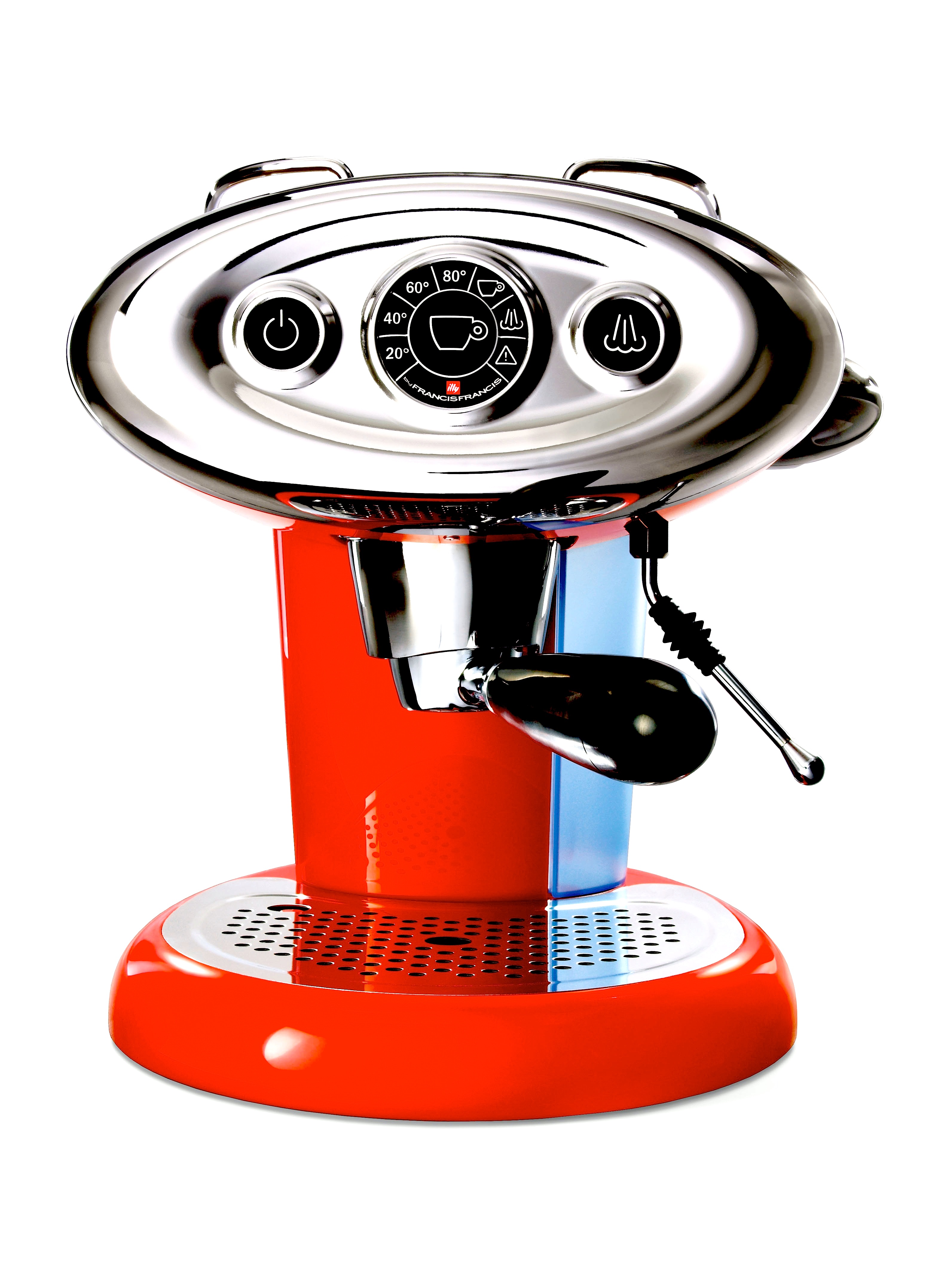 The new Illy Francis
Francis X7 IperEspresso machine
(below)--a great-looking art
deco "R2D2"-like design in various colors--also uses
pre-measured
plastic cartridges whose precise amount and grind of coffee is
controlled by laser. The coffee never
touches metal, so the only thing you ever have to clean is the catch
tray and the exterior of
the machine itself.
The new Illy Francis
Francis X7 IperEspresso machine
(below)--a great-looking art
deco "R2D2"-like design in various colors--also uses
pre-measured
plastic cartridges whose precise amount and grind of coffee is
controlled by laser. The coffee never
touches metal, so the only thing you ever have to clean is the catch
tray and the exterior of
the machine itself.
Air pressure forces out a precise amount of
coffee
in about 18 seconds, with the all-important, perfect layer of light
foaminess on top that Italians
call the “crema.”
The Illy Iper gives an
impeccable crema, and it
simply refuses
to dissipate, which is what 99.9 percent of all the espressos you will
ever be served in American will do within two seconds. In fact,
you
can leave the IperEspresso coffee sitting for ten minutes (by which
time it
will, of
course, be cold) and the crema
will still be intact. And
for this kind of no-error machine, you will pay only $395 at the moment
(I saw it on the Illy site for $150 not too long ago), which makes it
an amazing bargain.
Illy offers two kinds
of capsules--dark roast and the other a bit lighter--and they run about
75
cents each,
less if you order in bulk. The company also features its annual
signature
Artists' series cups, which has included designs by Jeff Koons, Julian
Schnabel, and, this fall, a beautiful series by director Pedro
Almodovar--the one at right has an image of Penelope Cruz on it
from
the director's new movie. These series have become collectors' items,
and they
run at different initial offering prices. Collect 'em all!
By the way, all these machines make excellent cappuccino,
too.
Such
innovations are making it hard for
anyone to screw up making a good cup of Italian coffee. Even a
busboy can do it. And about that lemon peel? It’s said people
used it in the old days to tame the bitterness of bad espresso. But an
old Neapolitan barista once
told me with a shrug, “The lemon peel? You
dip it in the sweet espresso and give it to a sick child to suck on to
calm his stomach."
NEW YORK CORNER
FINE
ITALIAN DINING NORTH OF NYC
by John Mariani
By sheer numbers, there are more
Italian restaurants of every stripe in Westchester County than anywhere
outside of a major city like New York or Los Angeles, and still they
proliferate. Here are two excellent newcomers, and another in
Greenwich, just across the Westchester/Connecticut, each with a good
pedigree. (From midtown Manhattan, they are a 45 minute-to-one hour's
drive.)
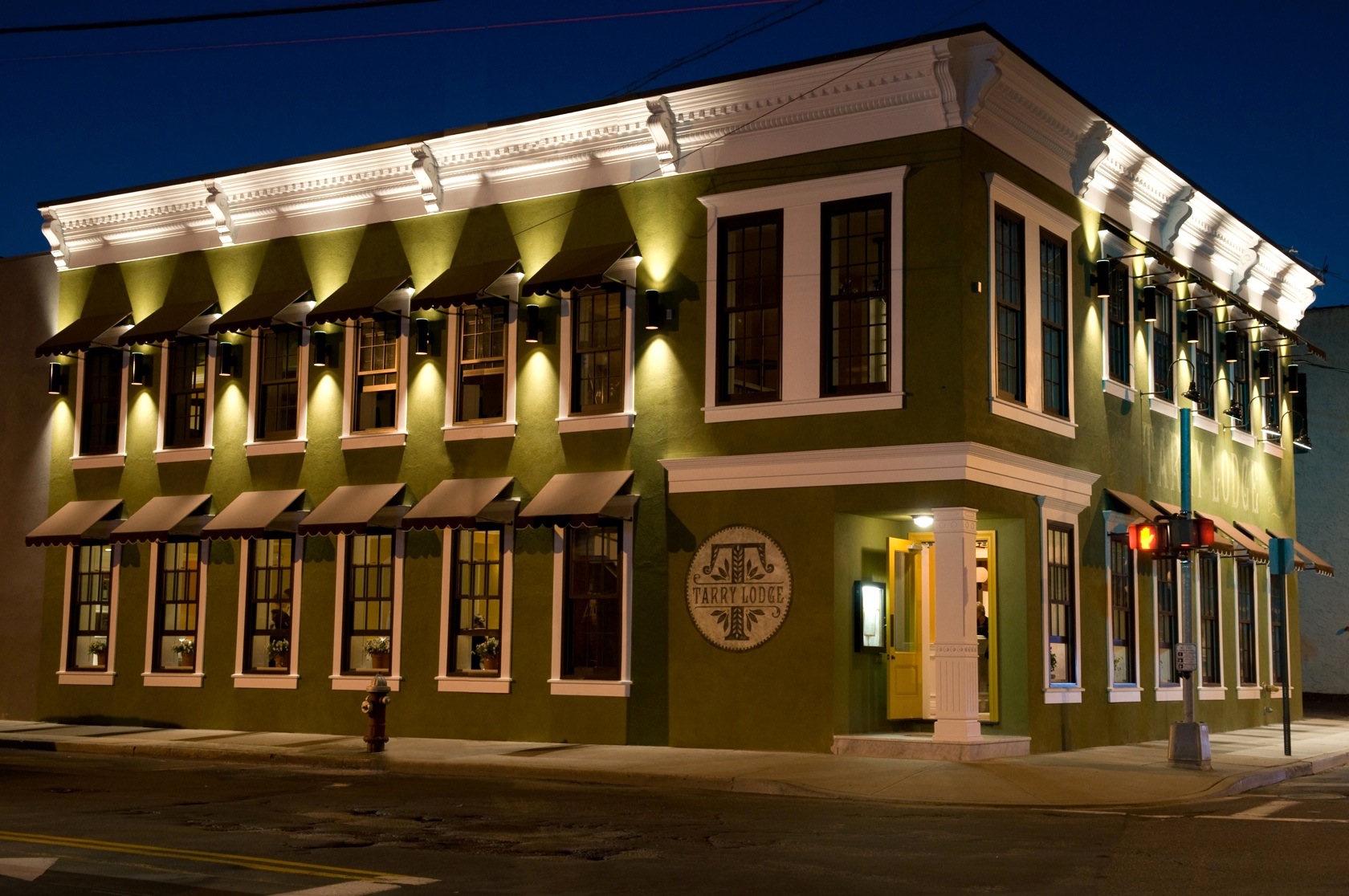 Tarry
Lodge
Tarry
Lodge
18 Mill Street
Port Chester, NY
914-939-3111
www.tarrylodge.com
The
formidable reputations of restaurateurs Mario Batali and Joseph
Bastianich have had tremendous impact on the success of the newly
revamped Tarry Lodge, which occupies an old restaurant in Port
Chester, set just a mile from the border of the Westchester/Connecticut
line.
The building itself is a century old, once a
speakeasy then a family restaurant, and its basic structure and
interior elements have a period charm that the new owners have
exploited to the fullest with beautiful period touches, good lighting,
and
optimal use of the two-and-a-half level space.
Since this is
now an Italian restaurant, I'm kind of surprised they didn't change
the cheery archaic name--maybe to Osteria del Porto?--but no matter.
The place looks great, bisected
between a bar/dining room (below)
with an elevated landing and a slender room as you enter, with more
seating upstairs, overlooking the street. At the bar--which they call a
saloon--you can have light meal and a quartino
of Chianti.
While it's highly unlikely you'll bump into
Mario at Tarry Lodge--both men are involved in scads of other
other enterprises
and media--there is a decent chance you will meet Joe, who lives nearby
in Greenwich. Chef Andy Nusser has worked at their Babbo, Casa Mono and
Bar Jamon in NYC, and he is always here, along with partner and manager
Nancy Selzer.
Those who go to Tarry Lodge hungry for the
kind of food served at any of those other restaurants or at
Bastianich-and-Batali's deluxe Del Posto may be puzzled by the menu
here, which more resembles one of Bastianich's other NYC restos,
Becco--fairly straightforward Italian food, mostly familiar, but with
more dash. By all means start off with a fine-crusted, thin
pizza--they run a very reasonable $10-$14--with toppings that range
from classic margherita to grilled ramps, pecorino, and chilies.
But the antipasti
are the soul of the menu here, from farro
grain mixed with broccoli di rabe, beets, and sweet-sour dressing to
octopus with baby potatoes, and a raft of excellent Italian hams and salume.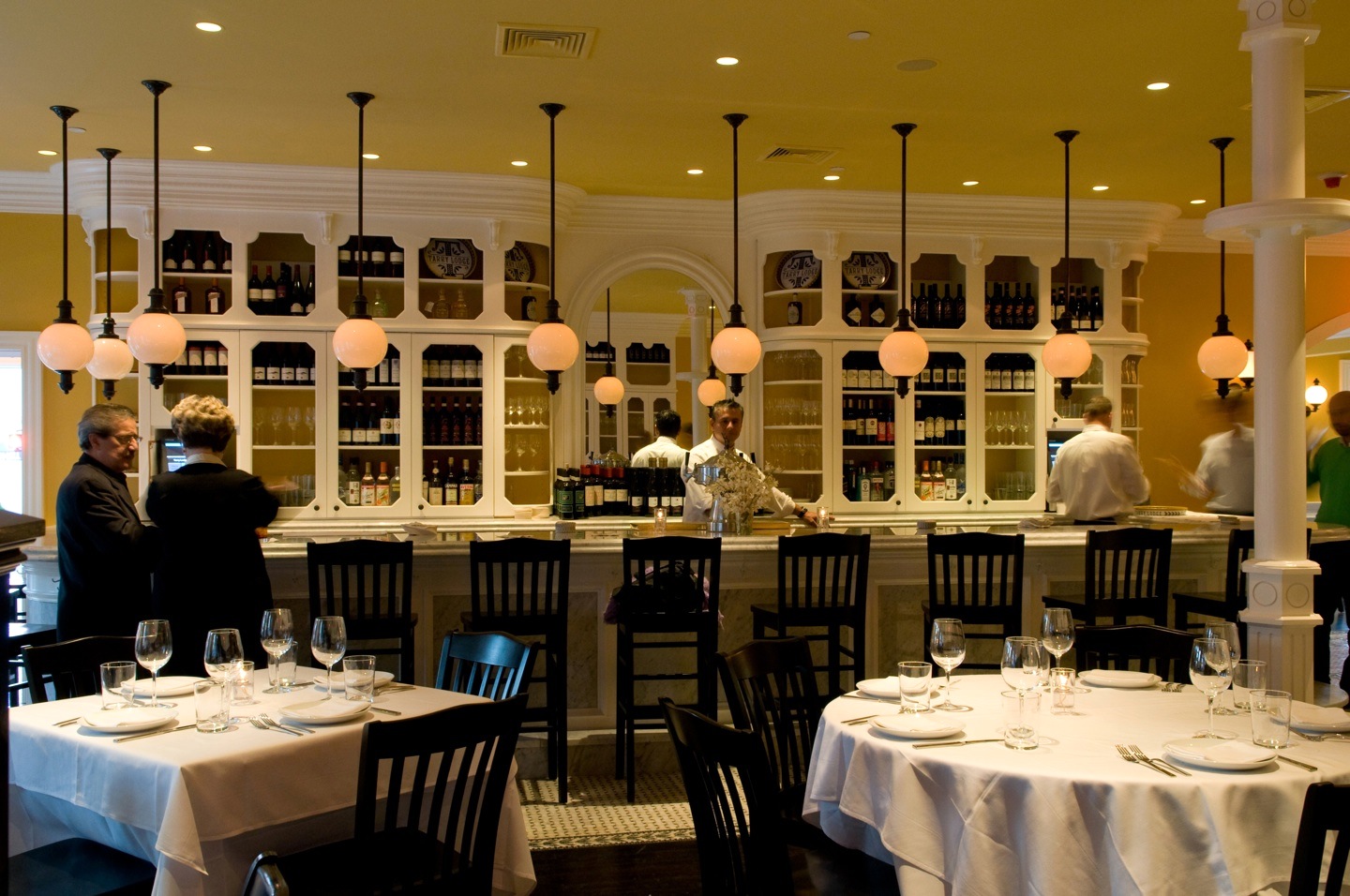
The
pasta section is mercifully short, meaning they can cook to
order--plump tortelloni with
peas and pancetta bacon; gnocchi
with braised oxtail; mezzalune
with fava beans and lemon
butter--all simply prepared with care in every
dish. The secondi
dishes stay mostly within safe grounds, from a whole roasted branzino with blood orange marmellatta (at $25, a steal);
old-fashioned osso buco with
green fregola; and a daily
special that might be lobster fra
diavolo on Monday, and lasagna
alla Napoletana on Sunday.
Desserts like strawberries with mascarpone and
panettone pudding with dulce de
leche gelato are winners, and at $8, easy to give in to.
As at the partners' Otto Enoteca in Greenwich
Village, the winelist is extensive in well-selected Italian bottlings,
although at the beginning Tarry Lodge's list was way overburdened with
labels well in excess of $100; now, there are plenty more well below
that figure, and they do offer those well-priced quartinos.
At lunch there a plenty of bargains on
the menu, including crispy orata with
fennel and orange at $15 and
grilled lamb chop with onions at $15.
______________________________________________________________________
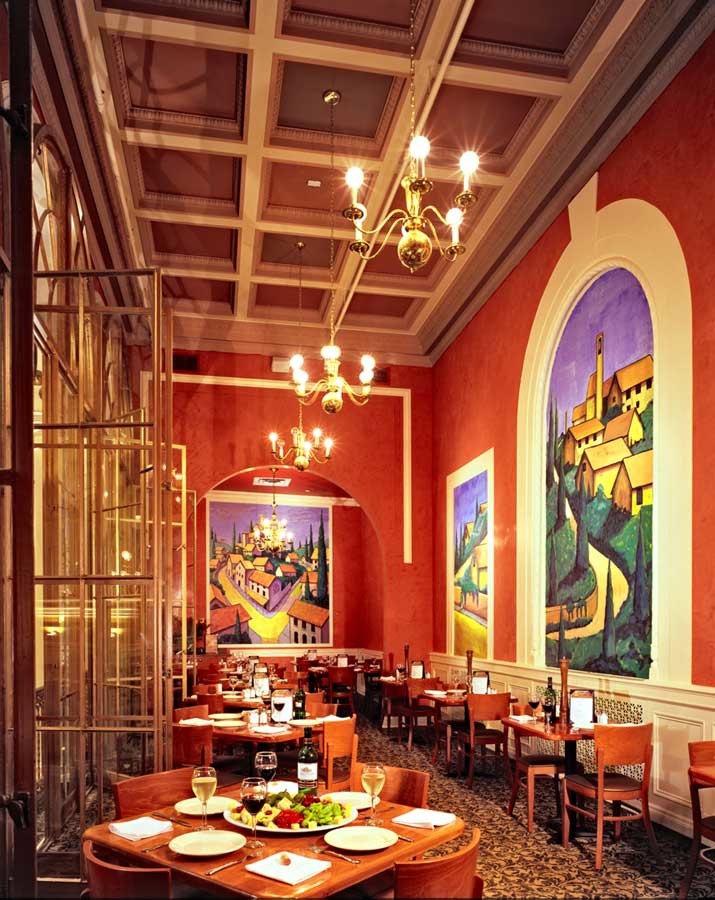 ZANARO'S
ZANARO'S
1
Mamaroneck Avenue
White Plains, NY
914-397-9400
www.zanarosny.com
Once
you get past Chef Joe DiMaggio, Jr.'s remarkable name (he's Old
Number 5's distant cousin)--and you won't miss him because he proudly
bestrides the dining room each night--and realize that his experience
in
cooking is about as solid as his namesake's was in baseball, you can
settle down at one of the spacious tables or booths in the huge
two-story restaurant and savor what he has to offer, all at good
prices.
DiMaggio (below)
has worked at his
family’s hotel in Bologna under Chef Piero
Carbonetti, then under Jacques Maximin at the Negresco Hotel in
Nice, later becoming CEO of Food Innovations, a "Direct from the
Source"
company delivering hard-to-source perishable ingredients from around
the world to chefs within 24 hours. DiMaggio came aboard at Zanaro's a
few
months ago to pull together a faltering enterprise that could seat 300
but rarely did. Now, the place is hopping weekdays and weekends.
Zanaro's décor is
close to being over the top, with its 40-foot ceiling and wraparound
balconies--thanks to its location in the former landmark
Home Savings Bank
Building, but the warm colors and the cordial greeting make
this a place to take the family or friends to have a darn good time.
DiMaggios credits his grandmothers for many of
his recipes, and they have that homey goodness and wholesomeness that
distinguish the casalinga
style. So his bolognese
sauce made from three meats takes a full
six hours to bring into focus, then it is served atop rigatoni.
His ingredients are the best he can find, including rabbits fed a
diet of juniper
berries.
Zanaro's now serves the requisite pizzas,
which are well rendered, including a "Pizza in Purgatory"
topped with poached eggs and
pepper oil, tomatoes, basil and Romano
cheese. Another comes with artichokes, caramelized onions and
sautéed spinach. The crust is a bit too thin for my
preference, but these are wonderful "pies."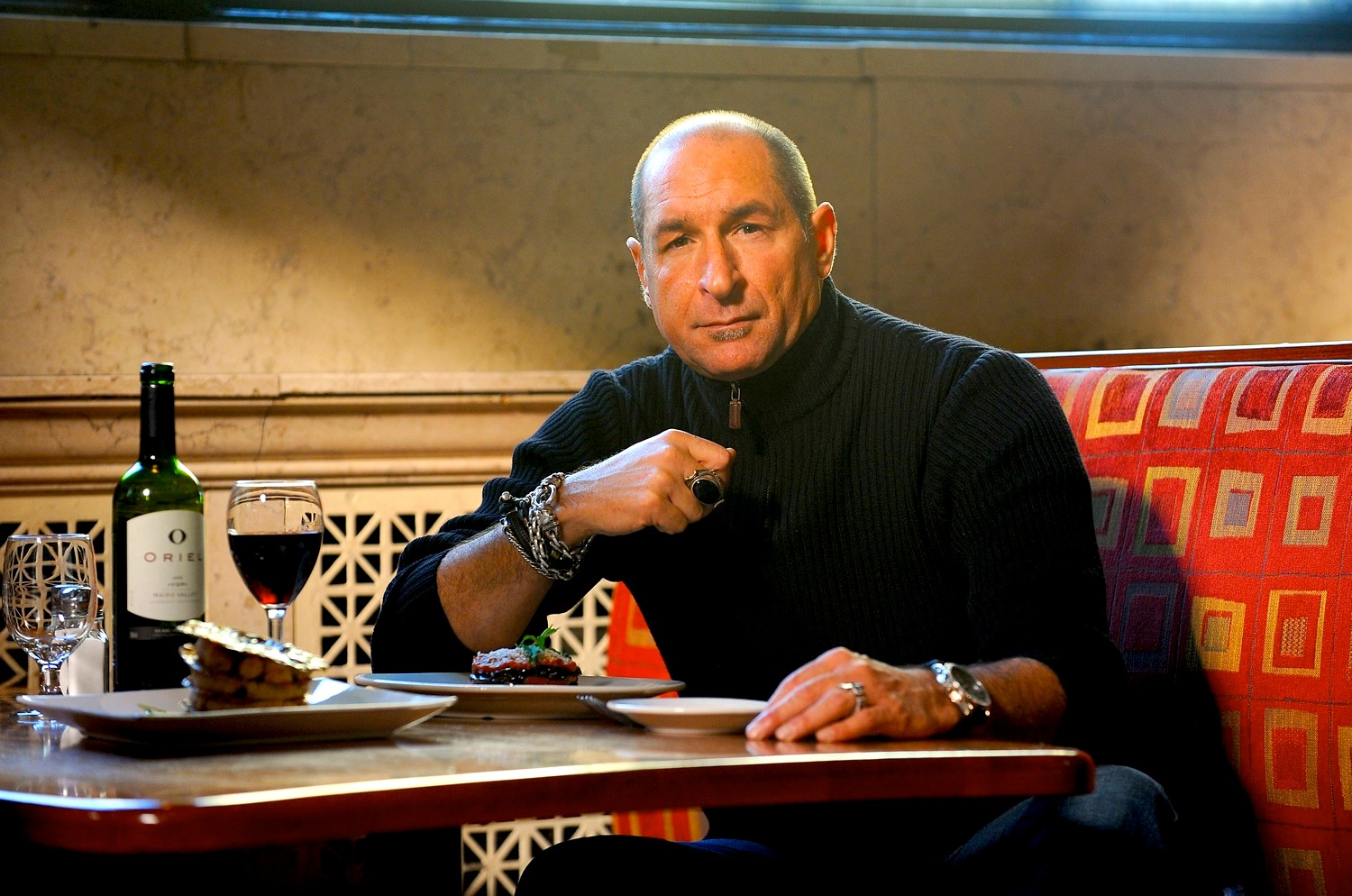
The salads are sumptuous, particularly the one
with prosciutto, soppressata,
provolone, roasted peppers, and much more.
Grandma is credited once again with a hefty
dish of lamb, beef, and pork meatballs, and spaghettini comes with
those
same meatballs. Pasta all'amatriciana
is an authoritative balance of spice and sweetness gained from pancetta bacon, red onion, and
tomatoes. But the spaghettini alla
carbonara would be better, and lighter, without heavy cream
mixed in with the onion, bacon, and peas.
Many items are cooked and served in black clay
pots, including seafood fra diavolo,
braised short ribs, and chicken scarpariello
with
sausage and peppers--all very good.
For dessert you can't go wrong with the lemon-coconut polenta
cake and a fine example of the ubiquitous tiramisù.
The winelist could be stronger in
a place of this largess, currently with about 50
selections, but they are well priced.
At the moment Zanaro's occupies a
unique position as a stellar Italian ristorante
in White Plains. But I hear talk that Zanaro's owner, Zane
Tankel (with Applebee's
and Chevy's franchises) and DiMaggio may take the concept into other
venues—not in itself a bad thing, but the more removed a chef like Joe
gets from the original ovens, the more diluted food can become. I hope
he stays right where he is.
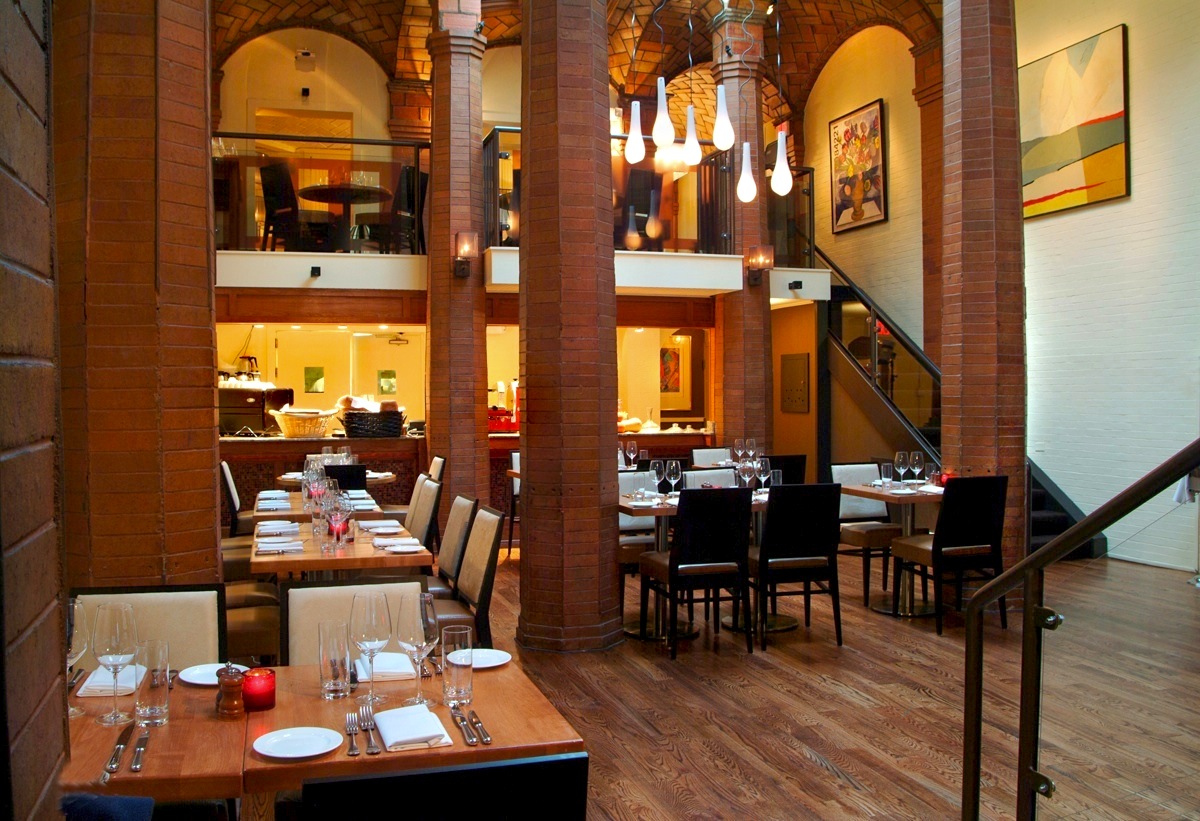 MORELLO
BISTRO
MORELLO
BISTRO
253 Greenwich Avenue
Greenwich, CT
203-661-3443
www.morellobistro.com
The premises of Morello Bistro, like
Zanaro's, was once a bank building, this one on Greenwich's main drag,
and the restaurant's
been through a few transmogrifications since then, first a very fine
French restaurant, then a more casual French restaurant, and now, as an
Italian-Mediterranean place that seems to have hit just the right mark
with the locals, who include residents of some of the wealthiest towns
along the Connecticut/Westchester Gold Coast that stretches by the Long
Island Sound.
Morello's owner, Marlon Abela,
runs
several fine dining spots in London as well as A Voce in NYC (written
about here last week: click),
and Morello is close in spirit to the
latter, though wholly different in design, which is spread over three
majestic levels of tiled archways (done by the famous Rafael
Guastavino, who also tiled the Great Hall on Ellis Island and Grand
Central Terminal's Oyster Bar). There are also mezzanine rooms
available for banquets. The whole place is quite an eyeful, and you
enter through a cozy bar--very popular in Greenwich--into this
magnificent
space.
Executive Chef Townsend Wentz (right) has come from
stints at Philadelphia's Four
Season's Hotel and Lacroix at the
Rittenhouse, then worked at A
Voce in preparation for the launch of Morello Bistro. He works
within the inspiration of A Voce, with big lusty flavors, well
portioned out. The menu is slightly bigger than it needs to be, trying
too hard
to please everyone, but from what I sampled one evening, most
everything is coming out right, starting with antipasti of crisp fried
calamari scented with oregano, lemon aïoli, and tomato
sauce for dipping; grilled octopus salad with frisée, radish,
fennel, 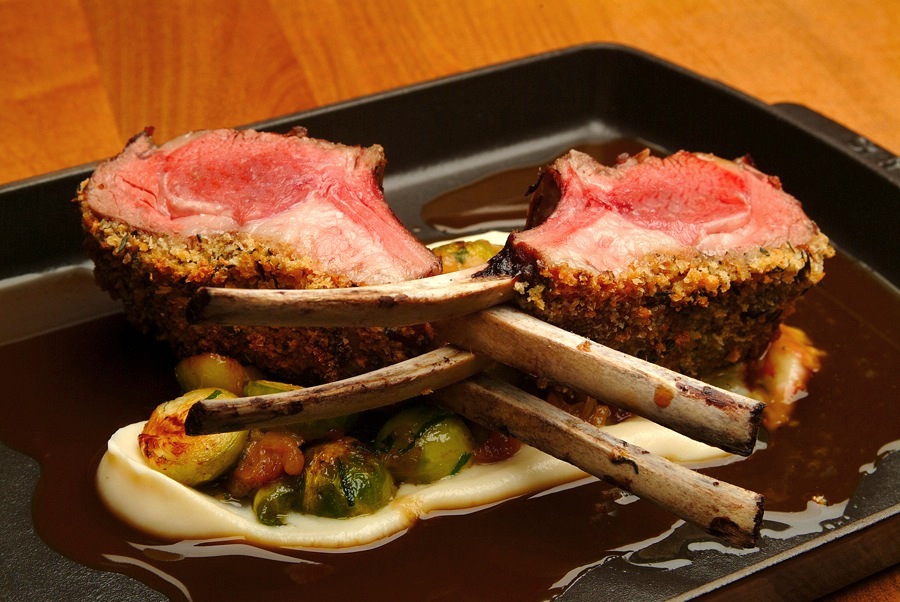 lemon,
and arugula Salad; and truly wonderful sea scallops with the
succulent addition of braised pork belly, ramps, farinata, and thyme.
lemon,
and arugula Salad; and truly wonderful sea scallops with the
succulent addition of braised pork belly, ramps, farinata, and thyme.
The pasta section offers both the usual
and the unusual, the latter including potato gnocchi with Speck, spring peas and
Moliterno
cheese, and pizzoccheri con calamari,
made with buckwheat flour.
Whether you're in the mood for fish or meat,
you will be well satisfied with Morello's sautéed branzino with
caramelized cippollini
onions, parsley root, and lemon; a terrific and
flavorful 16-ounce roasted veal chop; and the excellent rack of
lamb (left) with fava
beans, morel mushrooms, and rich braised lamb sugo. There is also a Puglian
specialty menu here at $38 for three courses.
One of Morello's strongest points is its
spectacular winelist, buoyed by the restaurant's previous
incarnation, with 750
selections, with half of them priced under $90, and 20+
offered by the glass.
Monday nights you may BYOB without a corkage fee.
Dress nice--but not dressy--Morello gets a
well-tuned Gold Coast crowd that makes sense of casual chic.
Morello Bistro is open for
lunch Mon.-Sat., brunch on Sun., and nightly for dinner. Antipasti at
dinner runs $7-$15, pastas (full portions) $20-$22, main courses,
$24-$36.
~~~~~~~~~~~~~~~~~~~~~~~~~~~~~~~
NOTES FROM THE WINE CELLAR
THE
DOURO BOYS
by Mort Hochstein
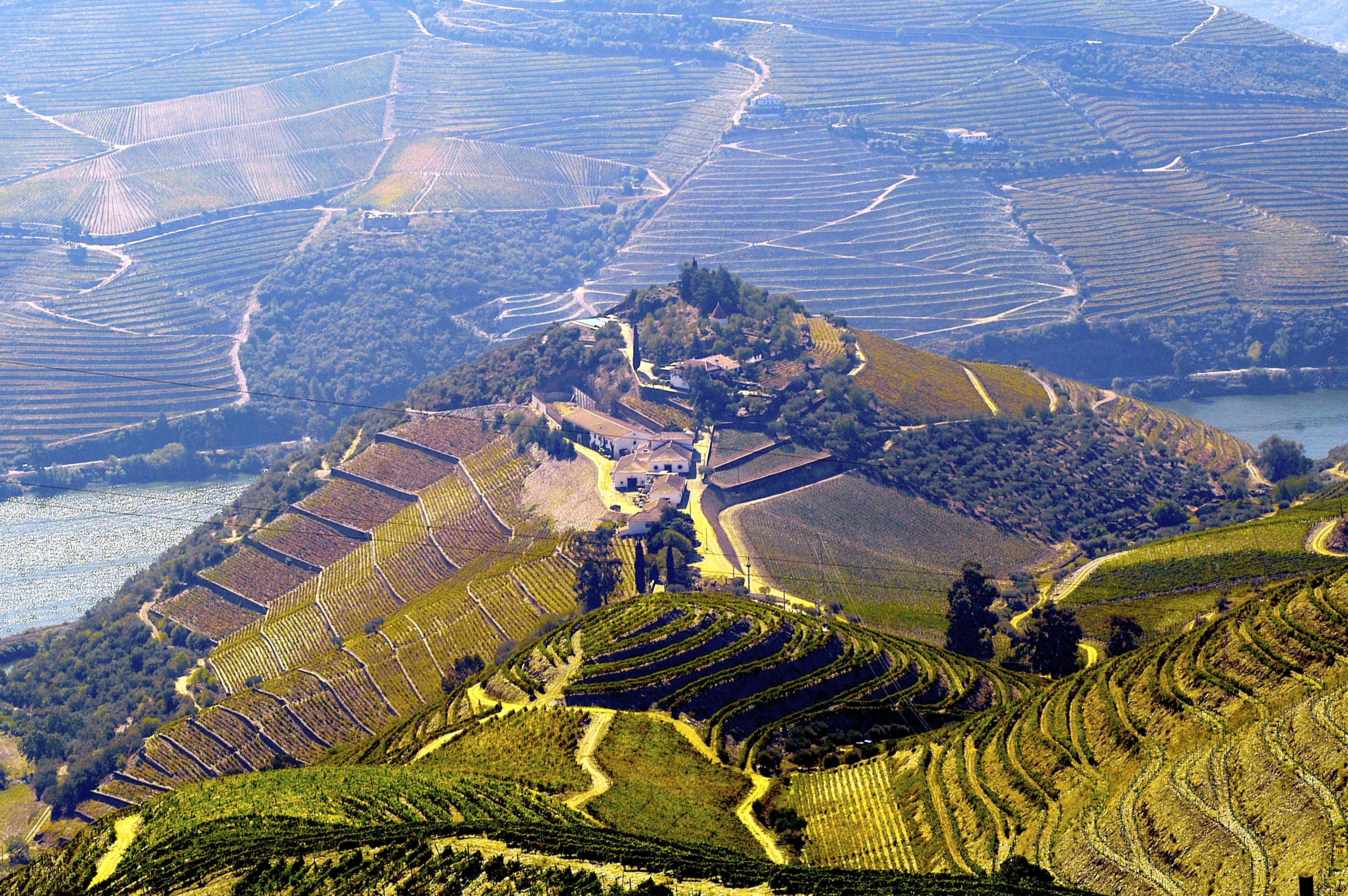 In
the early eighties, I made my first visit to the Douro region in
northern Portugal, the home of Port. Traveling by night on
one occasion, I clung to a tattered safety belt in a battered Volvo
station wagon as we humped our way over narrow mud roads. Those twists
and turns on unlighted roads that were little more than mud paths were
off-putting, but I might have been even more disturbed had
we been driving by daylight so that I could have seen how precariously
those roads clung to the edge of a towering mountain.
In
the early eighties, I made my first visit to the Douro region in
northern Portugal, the home of Port. Traveling by night on
one occasion, I clung to a tattered safety belt in a battered Volvo
station wagon as we humped our way over narrow mud roads. Those twists
and turns on unlighted roads that were little more than mud paths were
off-putting, but I might have been even more disturbed had
we been driving by daylight so that I could have seen how precariously
those roads clung to the edge of a towering mountain.
But it was close to midnight and the
light we followed was from our goal, a winery where we watched
laborers and their families pressing grapes the
old-fashioned way,
by stomping on them by foot in a concrete pit.
Purple-footed people still abound
in the Port region, and the roads I traveled in this,
one of the world’s oldest wine region, still twist
and turn and double back precipitously. But now they
are paved, almost comfortable,
and safer, though some of those farm routes can
still be rattling. On this journey, I came not to
taste Port but to explore the new excitement in these
steep-walled valleys and mountains where producers are crafting
extraordinary table wines and creating a renaissance in the
Douro.
Today the region is in flux as modern
wineries, inns, and other tourist accommodations are springing up where
once there were only quintas
(farms, equivalent to the French term châteaux)
and a long hard road to Porto and Vila Nova de Gaia, home of the Port
trade that dominated the region for so many years. The harshly rugged
banks of the Douro River now lead to some 40,000 hectares of vineyards.
It is a humbling sight as you travel the river road or on the ancient
single-track railway line along the water to see vines
clinging to terraces carved out of the towering mountains.
Cargo boats still work the river, and there
are cruises for tourists in the summer. It is a quiet yet exciting
landscape where visitors and wine travelers are just beginning to
appreciate the majesty of a region less traveled.
The Portuguese made wines here for several centuries, but
they were primarily for home consumption and table wines were almost an
afterthought to the business of raising grapes for Port. There has
always been a dribble of Portuguese table wine on the world market,
primarily in areas catering to Portuguese immigrants such as the
ironbound section in Newark, New Jersey, or along the New England
seacoast, where Portuguese fishermen settled.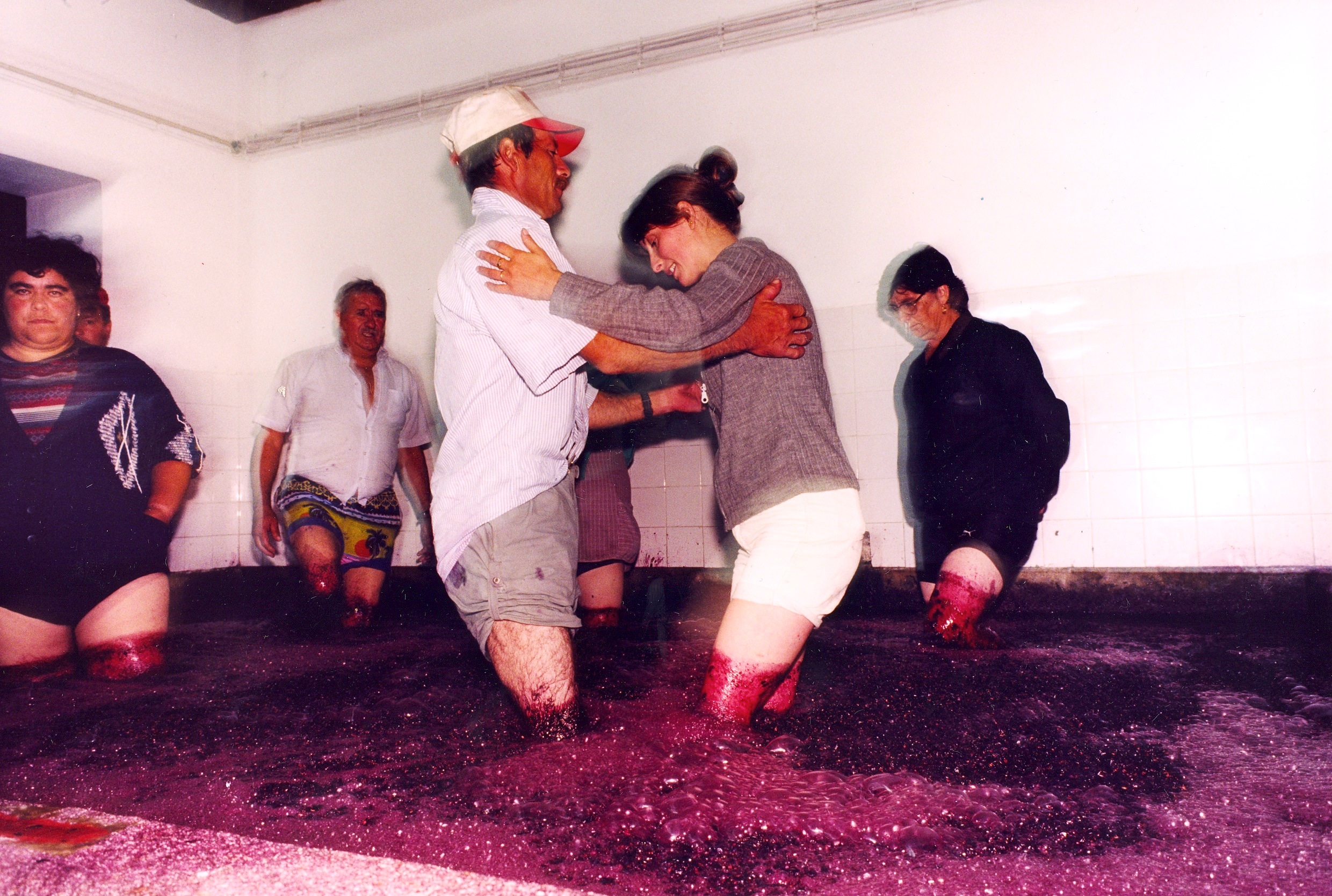
Those wines seldom appear on wine
lists, and it wasn’t until recent years that the Portuguese sent us any
notable still wines. In 1986, after Portugal joined
the European Economic Community, regulations which had favored Port
exporters and discouraged the production of fine wine, were revised,
giving impetus to growers to change their sights.
Miguel
Roquette of Quinta do Crasto,
one of the region’s leading winemakers, explains the revolution in the
Douro: “The big port houses controlled the trade, and it wasn’t until
’86 that the single quintas
were able to label and ship their own wines. We’ve always
produced table wine but largely for local consumption. Back
then it was ‘best grapes for Port and second quality for table wines.’
Obviously this has changed, but we have a long way to go until
Portuguese wine takes its place as a legitimate category on wine lists.”
Roquette is a member of a gang of five
Douro-area producers (below)
who’ve brought new world marketing techniques, as well as enological
and technological skills and traces their wine producing history back
to 1756. They’ve christened themselves "The Douro Boys," a
marketing tool that does not do justice to their experience, their age,
or the one female in the quintet. Many other producers are taking part
in the wine revolution in the Douro, but this quintet has made an
impact with a promotional drive backed up by 21st century
winemaking skills.
Relatively young and well connected,
from families with a long history in the Port trade, they are running
counter to worldwide trends by eschewing commercially popular varietals
such as Cabernet and Chardonnay (does the world need another
Chardonnay?) in favor of unknown, indigenous grapes.
Their wines are based on less familiar warm climate
varietals such as Tinta Barocca, Tinta Roriz, Touriga France, Touriga
Naçional and two dozen other types that have flourished locally
for several centuries. “Our wine,“ says Roquette, “is made from
30 indigenous varieties, and we feel that consumers looking for new
wine styles will find a different sensory experience in these old world
grapes.”
 The
wines from the Douro vary from producer to producer, but the best are
dark red with a hint of spice and layers of flavor from dark cherry to
mulberry and earthy mushroom. The best of them bring prices
rivaling super premium Cabernet and several have been elevated to cult
status.
The
wines from the Douro vary from producer to producer, but the best are
dark red with a hint of spice and layers of flavor from dark cherry to
mulberry and earthy mushroom. The best of them bring prices
rivaling super premium Cabernet and several have been elevated to cult
status.
Winemaker
Louis Seabra, who worked at Niepoort, another member of the Douro Boys,
hails the change, observing that “This group has been able to bring the
land back to the locals and produce wines just as they would have been
produced centuries ago.” That’s true more in theory than in
practice since the new crop of winemakers, many of whom trained
in vineyards around the world, have adapted the best of modern
viticultural techniques, have recruited New World consultants,
and have equipped their wineries with technology their
forefathers never envisioned.
Grapes in Portugal, as elsewhere, seem to wear many
names, depending on geography. Tinta Roriz, for example, is more
familiarly known elsewhere in the Iberian Peninsula as Tempranillo and
less familiarly recognized in the south as Aragonez. The Douro
wine list is a forest of new grape names and labels.
Port aficionados will recognize the name of
Niepoort, a long established Port house now making big strides,
blending new still wines from a veritable alphabet soup of grape types.
Others in the group are Quinta Do
Vale Dona Maria, home to winemaker Sandra Tavares,, a former
model who is the lone female in the gang of five; Quinta Do Vale Mao, and Quinta Do Vallado, which has made
Port for more than 200 years. There are dozens of other
winemakers changing the face of the region, but the Douro Boys have
jumped into the forefront with their skillful promotion,
traveling the world as a group and speaking not only for themselves,
but for the region.
Mort Hochstein, former editor and producer for NBC News and the Today
Show, and former managing editor of Nation's
Restaurant News, writes on wine, food and travel for Wine Spectator, Wine Business
Monthly, Saveur and other food and wine publications.
WRETCHED EXCESS NO.
4,556, REDNECK DIVISION
In Kansas
City, Missouri, 43-year-old
Karen Christine Downs and 25-year-old Kelsee Guestwere were arrested by
Platte County police to face felony
child-endangerment charges after allegedly providing liquor and beer to
six 13- and 14-year-olds at a birthday party for Downs'
daughter, offering
$10 to whoever could chug a glass of vodka the fastest, putting two
girls in the hospital.
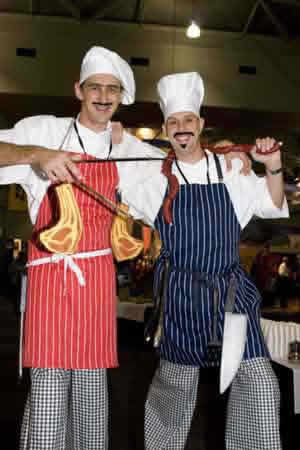
ANYONE ELSE
COME TO MIND?
"Chef Graham considers his cuisine to be fine art.
His spoons and knives are his brushes, his plates, his canvasses. In my
estimation his cuisine is the DaVinci, Michaelangelo and Rembrandt of
culinary art with a bit of Monet, Jackson Pollock and Claus Oldenberg
thrown in for surprise and humor."—Diane Shrago, “Graham Elliott
restaurant,” Splash Magazine.
~~~~~~~~~~~~~~~~~~~~~~~
* In New Orleans, Fair Grounds Race Course & Slots announces its Tastings at the Track Summer Series, in partnership with Dorignac’s Food Center, showcasing 25 top wines for $25 pp, with live entertainment by The Yat Pack. Tix available at Dorignac’s. Visit www.fairgroundsracecourse.com.
* In NYC Restaurant Daniel is offering a 15th Anniversary Menu for $98 pp Mon.-Thurs. from 5:30 PM - 6:30 PM. Call 212-288-0033.
* Seattle chef Tom Douglas announces his 3rd annual Culinary Summer Camp, in 2 sessions: July 12-July 16, and Aug. 9-13. Campers will work closely with Douglas and chefs from his restaurants, in addition to local and international celebrity chefs thru interactive demos and hands-on instruction. Douglas will lead an elaborate “How to Cook a Duck” demo. The July session will feature Takashi Yagihashi of Chicago's Takashi; Mirko Reeh, of Reehstaurant in Frankfurt, Germany; and Bruce Aidells of San Francisco. The August session’s lineup incl. Holly Smith, of Café Juanita, and Gale Gand, executive pastry chef and partner of Chicago’s Tru restaurant. $2,500 pp. Call 206-448-2001.
* On July 14 in Beverly Hills, CA, for Bastille Day, Maison 140 invites Angelenos to an evening of champagne, French wine, Pièce Montée (a traditional French wedding cake), French Cheese and fruit, and more. The evening’s festivities will also include the chance to win an exclusive “Vin et Fromage” wine and cheese tasting at Maison 140’s Bar Noir, hosted by Sophie Gayot of GAYOT.com; $85 pp (with $20 donated to The HOPE Program). Party-goers are offered a special $75 “take the elevator home” room rate for the evening. Call 310-281-4000; www.maison140beverlyhills.com.
* On July 14 in Los Angeles, Ortolan will be offering a 5-course Bstille Day menu for $75 pp. Call 323-653-3300.
* On July 15 in Los Angeles, the first of monthly Venetian Dinners will be held at All' Angelo. with owner Stefano Ongarao and Chef Roberto Franzoni, $45 + $28 for wine pairing. Visit www.allangelo.com; Call 323-933-9540.
* On July 20 in West Hollywood, CA, Los Angeles winemaker Sandy Garber will offer selections from Topanga Vineyards at Dominick’s, for $65 pep. Call 310- 652-2335; www.dominicksrestaurant.com.
* From
July 17-21 in Kirkland, WA,
"Kirkland Uncorked" will
showcase some of the newest lifestyle designs hitting the Pacific
Northwest in the Seattle Homes and Lifestyles Pavilion, with jazz
musicians and bands from Pony Boy Records; he Boat Show; a show
of 60+ wines from 20 Washington wineries in the Tasting and
Lifestyle Garden. Afterward, visit The Grape Choice Wine Shop featuring
bottles and cases of the varietals featured; Henry Weinhard’s
Beer Garden, pouring premium brands of Belgium Wheat, IPA, Private
Reserve, and more; tastings from Pacific Northwest’s finest restaurant
samplings. Visit www.kirklanduncorked.com.
* From
July 23-26 in Gunnison-Crested
Butte, CO, the 2nd annual
Crested Butte Land Trust Wine & Food Festival will showcase
hundreds of wines and amazing cuisine with seminars from $35-$50
each. Examples incl. Wine 101 and Blue Chip Wines of
Italy; a complete seminar schedule (with more being added as they are
booked) is available at www.crestedbuttewine.com.
* From
July 25-26 in LaFarge, WI,
the Kickapoo Country Fair will
be the Midwest's largest organic food and sustainability festival.
Presented by Organic Valley Family of Farms, Kickapoo Country Fair
brings together thousands of attendees for food, music, bike and farm
tours, cooking demonstrations, theater, kids’ activities, dancing,
author readings, and a keynote panel featuring organic pioneers – Visit
www.kickapoocountryfair.org, Call 888-444-6455.
* On
July 25, the James Beard Foundation will honor restaurateurs Alex von
Bidder and Julian Niccolini and celebrate the 50th anniversary of the
legendary Four Seasons Restaurant at
Chefs & Champagne® New York, held at the Wölffer
Estate Vineyard in Sagaponack, NY,
with culinary offerings from 30+ chefs, many from JBF Award
winning restaurants; and the wines of Wölffer Estate.
VIP Admission: $350 for JBF Members and General Public. VIP
tables of 10: $3,000; General Admission: JBF Members $175, Non-members
$250. Call 212-627-2308; www.jamesbeard.org/chefsandchampagne.
* From Aug. 22-29. Washington, DC's Taberna del Alabardero’s Chef Dani Arana wil lead a culinary cruise on The Great Lakes: A Voyage through North America’s Magnificent Inland Sea.Great Lakes, aboard Travel Dynamics International’s 100-guest Clelia II. During the cruise, Chef Arana will prepare special meals, offer passengers master classes and demonstrations, and conduct wine-tasting sessions as the ship voyages from Toronto, Canada to Duluth, Minnesota. Call 800-257-5767; visit www.TravelDynamicsInternational.com.
~~~~~~~~~~~~~~~~~
Everett Potter's Travel Report:

~~~~~~~~~~~~~~~~~~~~~~~~~~~~~~~~~~~~~~~~~~~~~~~~~~~~~~~~~~~~~~~~~~~~~~~~~~
Eating Las Vegas is the new on-line site for Virtual Gourmet contributor John A. Curtas., who since 1995 has been commenting on the Las Vegas food scene and reviewing restaurants for Nevada Public Radio. He is also the restaurant critic for KLAS TV, Channel 8 in Las Vegas, and his past reviews can be accessed at KNPR.org. Click on the logo below to go directly to his site.
~~~~~~~~~~~~~~~~~~~~~~~~~~~~~~~~~~~~~~~~~~~~~~~~~~~~~~~~~~~~~~~~~~~~~~~~~~~
Tennis Resorts Online: A Critical Guide to the World's Best Tennis Resorts and Tennis Camps, published by ROGER COX, who has spent more than two decades writing about tennis travel, including a 17-year stretch for Tennis magazine. He has also written for Arthur Frommer's Budget Travel, New York Magazine, Travel & Leisure, Esquire, Money, USTA Magazine, Men's Journal, and The Robb Report. He has authored two books-The World's Best Tennis Vacations (Stephen Greene Press/Viking Penguin, 1990) and The Best Places to Stay in the Rockies (Houghton Mifflin, 1992 & 1994), and the Melbourne (Australia) chapter to the Wall Street Journal Business Guide to Cities of the Pacific Rim (Fodor's Travel Guides, 1991). THIS WEEK: Tennis Participation Surges: 27 Million of Us

Family Travel
Forum: The
Family Travel Forum (FTF), whose motto is "Have Kids, Still Travel!",
is dedicated to the ideals, promotion and support of travel with
children. Founded by business professionals John Manton and Kyle
McCarthy with first class travel industry credentials and global family
travel experience, the independent, family-supported FTF will provide
its members with honest, unbiased information, informed advice and
practical tips; all designed to make traveling a rewarding, healthy,
safe, better value and hassle-free experience for adults and children
who journey together. Membership in FTF will lead you to new worlds of
adventure, fun and learning. Join the movement. THIS WEEK: A FAIRY TALE IN PRAGUE
All You Need to Know Before You Go
~~~~~~~~~~~~~~~~~~~~~~~~~~~~~~~~~~~~~~~~~~~~~~~~~~~~~~~~~~~~~~~~~~~~~~~~~
MARIANI'S VIRTUAL GOURMET NEWSLETTER is published weekly. Editor/Publisher: John Mariani.
Contributing Writers: Robert Mariani,
John A. Curtas, Edward Brivio, Mort
Hochstein, Suzanne Wright, and Brian Freedman. Contributing
Photographers: Galina Stepanoff-Dargery, Bobby Pirillo. Technical
Advisor: Gerry McLoughlin.
Any of John Mariani's books below
may be ordered from amazon.com by clicking on the cover image.
 My
newest book, written with my brother Robert Mariani, is a memoir of our
years growing up in the My
newest book, written with my brother Robert Mariani, is a memoir of our
years growing up in the For those of you who don't think of the Robert and I think you'll enjoy this very personal look at our --John Mariani |
 |
 |
 |
 |
 |
 |
© copyright John Mariani 2009
